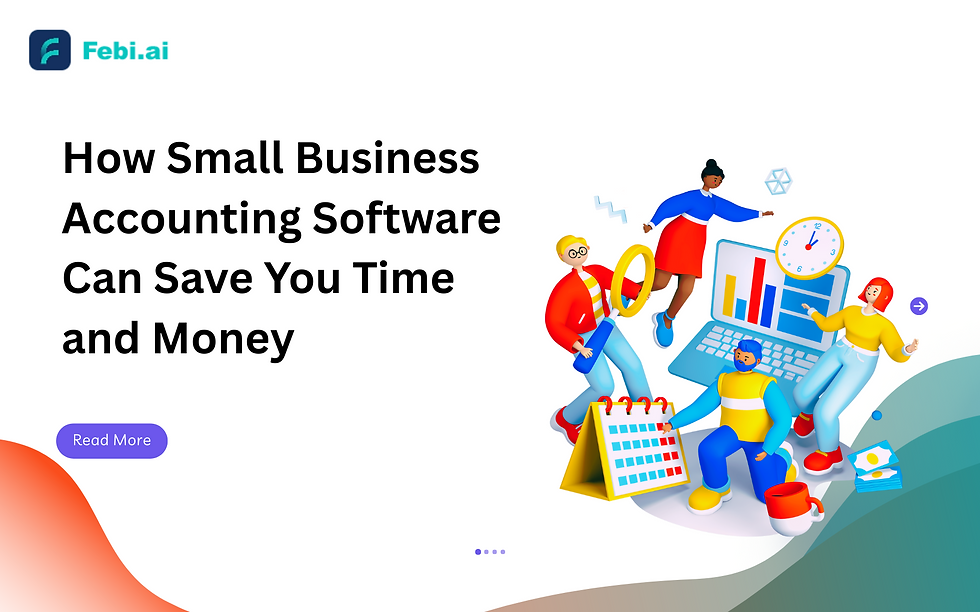How Small Business Accounting Software Can Save You Time and Money
- Riya Aggarwal

- Apr 28
- 3 min read
Introduction: The Growing Need for Smart Financial Management

In today's fast-paced business environment, small businesses must leverage technology to stay competitive. Managing finances manually is not only time-consuming but also prone to errors that can lead to costly consequences. Small business accounting software has emerged as a vital tool to streamline financial operations, enhance accuracy, and save valuable resources.
The Time-Saving Power of Small Business Accounting Software
Small business owners often juggle multiple roles, leaving little time for tedious financial tasks. Accounting software offers automation and efficiency that free up time to focus on growth.
Automation of Routine Tasks
Invoicing and Billing: Automatically generate and send professional invoices, set recurring invoices, and track payments.
Expense Tracking: Seamlessly categorize expenses by connecting bank feeds and credit cards, eliminating manual data entry.
Payroll Processing: Automate employee payments, tax calculations, and benefits management with minimal oversight.
Bank Reconciliation: Match transactions quickly, ensuring accurate and updated financial records without manual checks.
Real-Time Financial Insights
With built-in dashboards and customizable reports, accounting software offers real-time visibility into cash flow, outstanding invoices, and expense patterns. Business owners can make quicker, informed decisions instead of waiting for month-end reports.
Mobile Accessibility
Cloud-based accounting platforms allow business owners and managers to access financial data anytime, anywhere, using smartphones or tablets. This flexibility enables quicker approvals, faster transaction management, and on-the-go business oversight.
The Money-Saving Advantages of Accounting Software
Beyond saving time, small business accounting software also contributes to significant cost reductions, safeguarding your bottom line.
Minimization of Human Errors
Manual bookkeeping errors can lead to overpaid taxes, missed payments, and regulatory fines. Automated systems drastically reduce such mistakes, ensuring compliance and accurate reporting.
Reduction in Professional Fees
Efficient record-keeping reduces the workload for external accountants and auditors, potentially lowering their service charges. Some businesses even manage basic tax filings in-house with user-friendly software features.
Optimization of Cash Flow
Accurate tracking of income and expenses, coupled with insightful cash flow forecasting tools, helps businesses avoid overdraft fees, late penalties, and unnecessary borrowing costs.
Tax Savings and Deductions
Many accounting platforms help identify potential tax deductions throughout the year rather than during year-end crunch time. Accurate categorization of expenses ensures that no legitimate deductions are overlooked.
Key Features to Look for in Small Business Accounting Software
Choosing the right platform can further amplify time and cost savings. Essential features to prioritize include:
Automated Bank Feeds
Expense Categorization and Tracking
Invoicing and Payment Reminders
Tax Preparation Tools
Payroll Integration
Customizable Financial Reports
Cloud Access with Strong Security Protocols
Popular solutions like QuickBooks, Xero, and FreshBooks offer these features, enabling even non-accountants to manage business finances effectively.
Case Study: A Small Business Success Story
Consider a boutique design firm that transitioned from manual bookkeeping to cloud-based accounting software. Within six months:
Invoice payment time dropped by 40% through automated reminders.
Manual data entry reduced by 60%, saving 10+ hours per month.
Accounting service fees declined by 25% due to better organized, ready-to-review financial statements.
The time and financial resources saved were reinvested into marketing and product development, directly contributing to a 20% year-over-year revenue increase.
How to Implement Accounting Software for Maximum Efficiency
Implementing new technology can seem daunting, but a structured approach makes the transition smooth:
Assess Business Needs: Identify core accounting requirements and business goals.
Select the Right Software: Choose a platform tailored to your industry, company size, and future scalability.
Set Up and Integrate: Import existing financial data, set up bank feeds, and integrate with other business tools (e.g., CRM, payroll).
Train Your Team: Ensure everyone handling finances is trained to use the software effectively.
Monitor and Optimize: Regularly review software performance and optimize workflows for maximum benefit.
Conclusion: An Investment That Pays for Itself
Small business accounting software is not merely a luxury; it is a strategic necessity. By automating repetitive tasks, improving accuracy, and providing real-time insights, it saves precious time and money — resources that can be better invested in growing the business.
In a competitive market, leveraging technology for smart financial management could be the decisive factor between thriving and merely surviving. Choosing the right accounting software is a step towards greater operational efficiency, financial health, and long-term success.



Comments